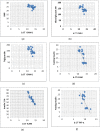Oral contraceptive pill (OCP) treatment alters the gene expression of intercellular adhesion molecule-1 (ICAM-1), tumor necrosis factor-α (TNF-α), monocyte chemoattractant protein-1 (MCP-1) and plasminogen activator inhibitor-1 (PAI-1) in polycystic ovary syndrome (PCOS) women compared to drug-naive PCOS women
- PMID: 36793022
- PMCID: PMC9933286
- DOI: 10.1186/s12905-023-02187-5
Oral contraceptive pill (OCP) treatment alters the gene expression of intercellular adhesion molecule-1 (ICAM-1), tumor necrosis factor-α (TNF-α), monocyte chemoattractant protein-1 (MCP-1) and plasminogen activator inhibitor-1 (PAI-1) in polycystic ovary syndrome (PCOS) women compared to drug-naive PCOS women
Abstract
Background: Polycystic ovary syndrome (PCOS) presents clinical symptoms of menstrual abnormalities, excessive hair growth (hirsutism), scalp hair loss, acne and infertility. Metabolic abnormalities such as obesity, insulin resistance, glucose intolerance and cardiovascular problems constitute an essential part of PCOS, all of which can have significant long-term health consequences. Low-grade chronic inflammation demonstrated by persistent moderately elevated serum levels of inflammatory and coagulatory markers plays a critical role in the pathogenesis of PCOS. Oral contraceptive pills (OCPs) constitute the mainstay of pharmacologic therapy for women with PCOS to regularize cyclicity and ameliorate androgen excess. On the other hand, OCP use is associated with various venous thromboembolic and proinflammatory events in the general population. PCOS women always carriers the increased lifetime risk of these events. The studies on the effect of OCPs on inflammatory, coagulation and metabolic parameters in PCOS are less robust. Therefore in this study, we investigated and compared the messenger RNA (mRNA) expression profiles of genes implicated in inflammatory and coagulation pathways between drug-naive and OCP-treated PCOS women. The selected genes include intercellular adhesion molecule-1 (ICAM-1), tumor necrosis factor-α (TNF-α), monocyte chemoattractant protein-1 (MCP-1) and plasminogen activator inhibitor-1 (PAI-1). Furthermore, the correlation between the selected markers and various metabolic indices in the OCP group has also been explored.
Method: The relative amounts of ICAM-1, TNF-α, MCP-1 and PAI-1 mRNA in peripheral blood mononuclear cells from 25 drug-naive PCOS subjects (controls) and 25 PCOS subjects who received OCPs containing 0.03 mg-ethinyl-estradiol and 0.15 mg-levonorgestrel for at least six months (cases) were estimated using real-time qPCR. The statistical interpretation was conducted using SPSS version 20.0 (SPSS, Inc, Chicago, IL), Epi Info version 2002 (Disease Control and Prevention Centres, Atlanta, GA) and GraphPad Prism 5 (GraphPad Software, La Jolla, CA) software.
Result: Six months of OCP therapy enhanced the expression of inflammatory genes viz ICAM-1, TNF-α and MCP-1 mRNA in PCOS women by 2.54, 2.05 and 1.74 folds, respectively, in this study. However, PAI-1 mRNA in the OCP group showed no significant increase. Furthermore, in cases, ICAM-1 mRNA expression positively correlated with body mass index (BMI) (p = 0.01), fasting insulin (p = 0.01), insulin 2 h p = 0.02), glucose 2 h (p = 0.01) and triglycerides (p = 0.01). TNF-α mRNA expression positively correlated with fasting insulin (p = 0.0007). MCP-1 mRNA expression positively correlated with (BMI) (p = 0.002).
Conclusion: OCPs helped reduce clinical hyperandrogenism and regularise menstrual cycles in women with PCOS. However, OCP use was associated with increased fold expression of inflammatory markers which positively correlated with metabolic abnormalities.
Keywords: Coagulation; Inflammation; Insulin resistance; Monocyte chemoattractant protein-1; Oral contraceptive pill; Plasminogen activator inhabitor-1; Polycystic ovary syndrome; Tumor necrosis factor-α.
© 2023. The Author(s).
Conflict of interest statement
The authors declare that they have no competing interests.
Figures




Similar articles
-
Does the Oral Contraceptive Pill Increase Plasma Intercellular Adhesion Molecule-1, Monocyte Chemoattractant Protein-1, and Tumor Necrosis Factor-α Levels in Women with Polycystic Ovary Syndrome: A Pilot Study.J Pediatr Adolesc Gynecol. 2017 Feb;30(1):58-62. doi: 10.1016/j.jpag.2016.06.010. Epub 2016 Jul 2. J Pediatr Adolesc Gynecol. 2017. PMID: 27381237
-
Effect of six-month use of oral contraceptive pills on plasminogen activator inhibitor-1 & factor VIII among women with polycystic ovary syndrome: An observational pilot study.Indian J Med Res. 2018 Dec;148(Suppl):S151-S155. doi: 10.4103/ijmr.IJMR_1899_17. Indian J Med Res. 2018. PMID: 30964093 Free PMC article.
-
Expression levels of vascular cell adhesion molecule-1 in young and nonobese women with polycystic ovary syndrome.Gynecol Obstet Invest. 2012;73(3):236-41. doi: 10.1159/000334175. Epub 2012 Mar 21. Gynecol Obstet Invest. 2012. PMID: 22441212
-
AMERICAN ASSOCIATION OF CLINICAL ENDOCRINOLOGISTS, AMERICAN COLLEGE OF ENDOCRINOLOGY, AND ANDROGEN EXCESS AND PCOS SOCIETY DISEASE STATE CLINICAL REVIEW: GUIDE TO THE BEST PRACTICES IN THE EVALUATION AND TREATMENT OF POLYCYSTIC OVARY SYNDROME - PART 2.Endocr Pract. 2015 Dec;21(12):1415-26. doi: 10.4158/EP15748.DSCPT2. Endocr Pract. 2015. PMID: 26642102 Review.
-
Chronic Low Grade Inflammation in Pathogenesis of PCOS.Int J Mol Sci. 2021 Apr 6;22(7):3789. doi: 10.3390/ijms22073789. Int J Mol Sci. 2021. PMID: 33917519 Free PMC article. Review.
Cited by
-
Mesenchymal Stromal Cell Exosome-Induced Vascular Regeneration in a PCOS Mouse Model.Reprod Sci. 2025 Mar;32(3):825-835. doi: 10.1007/s43032-024-01720-7. Epub 2024 Oct 15. Reprod Sci. 2025. PMID: 39407058
-
Androgen excess: a hallmark of polycystic ovary syndrome.Front Endocrinol (Lausanne). 2023 Dec 13;14:1273542. doi: 10.3389/fendo.2023.1273542. eCollection 2023. Front Endocrinol (Lausanne). 2023. PMID: 38152131 Free PMC article. Review.
-
The Molecular Basis of Polycystic Ovary Syndrome and Its Cardiometabolic Correlates: Exploring the Intersection and Its Clinical Implications-A Narrative Review.Biomedicines. 2025 Mar 13;13(3):709. doi: 10.3390/biomedicines13030709. Biomedicines. 2025. PMID: 40149685 Free PMC article. Review.
-
Usefulness of the Sympto-Thermal Method with Standardized Cervical Mucus Assessment (InVivo Method) for Evaluating the Monthly Cycle in Women with Polycystic Ovary Syndrome (PCOS).Healthcare (Basel). 2024 May 29;12(11):1108. doi: 10.3390/healthcare12111108. Healthcare (Basel). 2024. PMID: 38891183 Free PMC article.
-
Effects of interleukin-1 receptor antagonism in women with polycystic ovary syndrome-the FertIL trial.Front Endocrinol (Lausanne). 2024 Sep 11;15:1435698. doi: 10.3389/fendo.2024.1435698. eCollection 2024. Front Endocrinol (Lausanne). 2024. PMID: 39324125 Free PMC article. Clinical Trial.
References
-
- Cirillo F, Catellani C, Lazzeroni P, Sartori C, Nicoli A, Amarri S, et al. MiRNAs regulating insulin sensitivity are dysregulated in polycystic ovary syndrome (PCOS) ovaries and are associated with markers of inflammation and insulin sensitivity. Front Endocrinol (Lausanne) 2019;10:879. doi: 10.3389/fendo.2019.00879. - DOI - PMC - PubMed
Publication types
MeSH terms
Substances
Grants and funding
LinkOut - more resources
Full Text Sources
Medical
Research Materials
Miscellaneous

